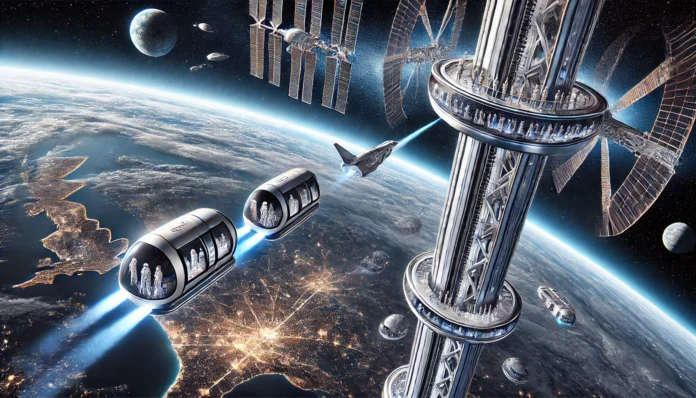Space tourism, once a dream confined to the pages of science fiction, is now becoming a tangible reality. With private companies like SpaceX, Blue Origin, and Virgin Galactic pioneering commercial space travel, the industry is set to grow exponentially. Among the most ambitious and revolutionary ideas in this field is the space elevator, a concept that could make space travel safer, more sustainable, and accessible for millions.
This article explores the fascinating concept of space elevators, their potential impact on space tourism, and the challenges that lie ahead.
What is a Space Elevator?
A space elevator is a proposed mega-structure designed to connect Earth’s surface to outer space. This concept envisions a tether anchored to the equator, extending upward into space well beyond geostationary orbit. Vehicles, called “climbers,” would ascend and descend this tether to transport passengers, cargo, and supplies.
Key Components of a Space Elevator:
- Ground Station: A large base, likely located near the equator, that serves as the operational hub for the elevator.
- Tether: Made of ultra-strong materials, such as carbon nanotubes or graphene, capable of withstanding immense tension.
- Climbers: Electrically powered vehicles that ascend the tether, carrying passengers and goods.
- Counterweight: Positioned beyond geostationary orbit to maintain the tether’s stability and balance.
Why Space Elevators are a Game-Changer for Space Tourism
Current space travel relies heavily on rockets, which are expensive, environmentally taxing, and inherently risky. Space elevators offer a transformative alternative, with several benefits for space tourism:
- Cost Efficiency: Once built, a space elevator could drastically reduce the cost of sending passengers and materials to orbit, making space tourism affordable for a broader audience.
- Safety: Without the risks associated with rocket propulsion and launch failures, space elevators promise a safer mode of space travel.
- Sustainability: Unlike rockets, which consume large amounts of fuel, space elevators could be powered by renewable energy sources, minimizing their environmental impact.
- Enhanced Experience: Space elevators offer a gradual ascent, allowing tourists to enjoy breathtaking views of Earth, from lush green forests to the shimmering oceans, all from the comfort of their telecabin.
The Space Tourism Experience
Imagine embarking on a journey aboard a space elevator telecabin, starting from a high-tech spaceport. The ascent, lasting several hours, would offer unmatched views of Earth and the transition into space. Highlights of the experience could include:
- Observation Decks: Panoramic windows to witness Earth’s curvature and the vastness of space.
- Weightlessness Areas: Zones within the telecabin for passengers to experience microgravity.
- Luxury Services: Fine dining, interactive science exhibits, and even space-themed entertainment.
At the elevator’s terminus, passengers could disembark at a space station, where they could:
- Stay in orbital hotels with zero-gravity accommodations.
- Participate in spacewalks with professional astronauts.
- Continue their journey to the Moon or Mars.
Challenges in Building a Space Elevator
While the potential of space elevators is immense, significant technical and logistical hurdles must be overcome:
- Material Strength: Current materials are insufficient to construct a tether capable of supporting its own weight against gravitational and centrifugal forces. Research into advanced materials like graphene and carbon nanotubes is ongoing.
- Space Debris: Protecting the tether from collisions with meteoroids and debris in orbit is a critical challenge.
- Energy Requirements: Developing efficient systems to power climbers over tens of thousands of kilometers is essential.
- Financial Feasibility: The construction of a space elevator requires an unprecedented level of funding and international collaboration.
The Future of Space Tourism with Space Elevators
Despite these challenges, the space elevator remains one of the most promising technologies for democratizing space access. It represents a sustainable, safe, and efficient pathway to space, complementing advancements in reusable rockets and orbital infrastructure.
When space elevators become a reality, they could:
- Propel the space tourism industry to new heights, enabling mass-market space travel.
- Facilitate scientific research by providing cost-effective access to space.
- Transform industries like satellite deployment, cargo transport, and even interplanetary travel.
Conclusion
The space elevator is not just a marvel of engineering but a symbol of humanity’s boundless ambition. Its development could redefine how we interact with space, making it a routine part of life rather than an exclusive domain of astronauts and billionaires.
As companies and researchers push the boundaries of technology, the dream of space tourism may soon include an elevator ride to the stars. Stay tuned to Tecific.com for more updates on cutting-edge technologies and visionary projects shaping our future.




